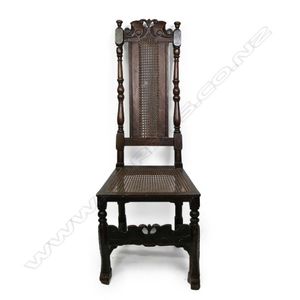Antique Jacobean Style Fruitwood Chair with Cane Seat
A George III fruitwood Jacobean style chair, panelled cane seat and high back. Some old repairs and borer.
You must be a subscriber, and be logged in to view price and dealer details.
Subscribe Now to view actual auction price for this item
When you subscribe, you have the option of setting the currency in which to display prices to $Au, $US, $NZ or Stg.
This item has been sold, and the description, image and price are for reference purposes only.
- Cane in Furniture Making - Cane, as used to make furniture is harvested from the ratan palm. The rattan palm is a type of climbing palm that is native to tropical regions of Asia and Africa. The stem of the rattan palm, also known as cane, is harvested, stripped of its skin, and then used to make a variety of furniture items. Rattan furniture is known for its durability, lightness and natural beauty. The cane is flexible yet strong and can be woven into various patterns, making it suitable for a wide range of furniture styles from traditional to modern. The furniture made from rattan cane is also known for its durability and resistance to extreme weather conditions. Popular items include chairs, tables, sofas, and cabinets. The natural colour of the cane can be preserved or it can be stained or painted for different looks.
- George Iii - George III (1738 - 1820) was King of Great Britain and Ireland from 1760 to 1820.
- Fruitwood - A catch-all term used to describe the wood of any of several fruit-bearing trees, such as the apple, cherry, or pear, used especially in cabinetmaking.
With a blond colour when finished, fruitwood was used in Europe, especially France, in the 18th and 19th centuries for larger items of furniture such as tables, chairs, cabinets and bookcases but in England its use was generally restricted to decorative elements such as inlays. - Jacobean - Jacobean is the name applied to the style of furniture and decorative arts in vogue from about 1600 to 1630 which includes the reign of James I (1603-1625). The most common timber used is oak, and it is ornamented with turning and elaborate carving. Characteristic of decoration of furniture in this style are bun feet, mortice and tenon joints (replacing dowell joints) and 'X' frame chairs.
The style was revived in the 19th furniture (Jacobean Revival or "Jacobean style") as represented by most of the furniture coming onto the market in Australia, that is described as "Jacobean".
This item has been included into following indexes:
